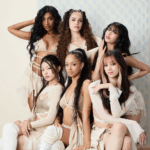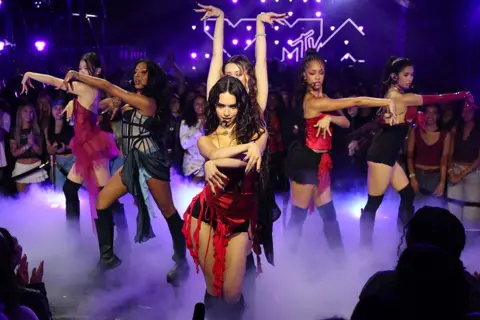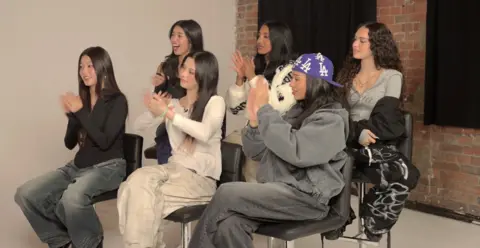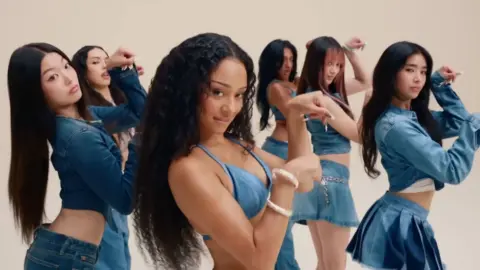
The girl group Katseye say they have received multiple online death threats since they made their debut last year.
The six-piece, who were recently nominated for best new artist at the Grammy Awards, told BBC News that the messages, which have also targeted their families, “can get really heavy”.
“I try to tell myself it doesn’t matter, but if 1,000 people are sending you death threats, it’s jarring,” said singer Lara Raj. “Even if it’s not going to happen, it’s heavy.”
Raj, who is a US citizen with Tamil Indian heritage, has also been subjected to racist comments, and was falsely reported to ICE for “working and residing in the United States without legal authorisation”.
The 20-year-old said she had “deleted Twitter” (now known as X), to avoid seeing negative comments.
“I realised I am not the audience for other people’s opinions,” she said.
Katseye did not specify the nature of the threats they have received; but aggressive and inappropriate behaviour is depressingly common amongst fan communities.
Last year, Chappell Roan criticised the “many nonconsensual physical and social interactions” she had had with fans, including people harassing her family and friends.
The pop band Muna chastised some of their supporters for “spreading falsehoods about us and our loved ones for clout and attention”; while Doja Cat called out “creepy” behaviour from a section of her fanbase.
“Our career has been really short, but I feel like we’ve gotten a lot of things already said to us, to our families,” said Katseye singer Sophia Laforteza.
“We know that we signed up for being so public. We know it’s a part of fame. But it doesn’t change the fact that we are human.”
Raj also pointed out the sexist nature of the comments the band have received.
“People see us as women to rank. They’ll grade us based on how pretty we are, our singing skill, dancing skill, and then add it up and give us a percentage.
“That’s so dystopian.”
“I feel like it’s very terrifying on the mind,” added her bandmate Manon Bannerman.

Despite the online negativity, Katseye are having a remarkable year.
Their second EP, Beautiful Chaos, peaked at number two in the US album charts, thanks to the gratingly brilliant lead single, Gnarly, and the Charli XCX-penned follow-up, Gabriella.
An advert they filmed for the clothing brand Gap went viral in August, racking up 400 million plays and 8 billion social media “impressions” (“Isn’t there only 7 billion people in the world?” asked singer Megan Skiendiel when presented with the statistic).
Last month, they won best performance at the MTV Awards. Five days ago, they became only the third girl group in history to receive a best new artist nomination at the Grammys, following SWV and Wilson Phillips.
The six members, who range in age between 17 and 22, are truly international.
Daniela Avanzini is a Venezuelan-Cuban American from Atlanta. Raj is an Indian-Sri Lankan American from New York. Bannerman is a Ghanaian-Italian from Zurich. Megan Skiendiel is a Chinese-Singaporean American from Honolulu. Laforteza is from Manila in the Philippines. And Yoonchae Jeung was born and raised in South Korea.

They were hand-picked to form Katseye on The Debut: Dream Academy, a reality show created by Korean entertainment giant Hybe – the label behind BTS and Le Sserafim – and America’s Geffen Records, home to Olivia Rodrigo and Guns N’ Roses.
Thousands applied, but only 20 made it through to the training and development stage – a gruelling, two-year bootcamp of daily dance lessons, vocal practice and brutal feedback.
Rehearsing one dance routine, they were scolded for their lack of synchronisation: “It’s got to sound like one person walking down the stairs. It can’t sound like a group of people falling down the stairs.”
Those days are long behind them. The sextet learned the intricate, aerobic choreography for their Gap advert in just one day.
“The longer we’re together as a group, the shorter it takes,” said Skiendiel.
“One day of rehearsals and we’re really in sync. Then we nitpick the rest.”

Last year’s SIS (Soft Is Strong) EP established the band with a confident, slick pop sound. But it was Gnarly that really put them on the map.
Released in April, the song is two minutes and seventeen seconds of aggressively chaotic beat drops, juddering synths and gang vocals.
It instantly divided opinion: “Genuinely atrocious” was one of the kinder comments. “But people kept coming back for more. At the time of writing, it’s been streamed more than half a billion times. No less than The New York Times called it “the future of K-pop”.
“When we first heard it, we knew it was going to be shocking,” said Avanzini.
“That was so exciting, the idea of making people upset,” agreed Raj. “Not giving them something that’s just okay – we were really giving something thrilling.”
It may have been polarising – but Gnarly turned Katseye from a pop curiosity to a burgeoning cultural phenomenon.
One early fan was Melanie C, who hosted a showcase for the band in London last month.
Speaking on stage, she said Katseye reminded her of the Spice Girls.
“Something about the Spice Girls was so many people felt they could identify with one of us,” she said. “And I think that’s so beautiful about [the diversity of] your band: You open that door even further for so many people.”
“We pride ourselves so much that our group is so diverse,” Bannerman told the BBC.
“It’s our number one priority to show the girlies out there to be proud of where they come from, no matter what they look like.”
And, despite the online pushback she’s received, Raj encourages musicians from diverse backgrounds to pursue their dreams.
“Please do it,” she told the BBC. “You cannot feel held back.
“Our skin colour, our culture is our power. Use it and own it.”